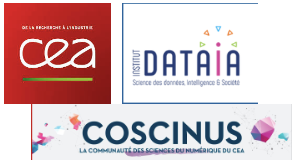- Artificial intelligence techniques for advanced modeling of accelerators
Barbara Dalena, Davide Faranda, Valérie Gautard
The aim of this stage is to explore the possibility to use Artificial Intelligence (i.e. Machine Learning and Deep Learning techniques) in order to reduce computational time in the simulations of the Dynamic Aperture (DA) of future circular particles accelerators. The prediction of the long-term DA, which is defined as the border between regular and chaotic motion, is used to define tolerances on field quality and non-linear corrections schemes in the optics design of the accelerator. In order to find the DA a Poincaré section from tracking along the accelerator is required. It describes the turn-by-turn behavior of a particle as it passes a point periodically in the elements of the accelerator. Based on these Poincaré section the DA can be defined in different way: as the limit corresponding to particle losses at 10^n revolutions in the accelerator or using the rate of divergence of nearby trajectories in the phase space to define the limit between chaotic and non-chaotic motion. The student will explore the possibility to predict such DA for different configurations of the machine and to extrapolate DA from 10^3 to 10^n, with n> 3 using Machine Learning and/or Deep Learning techniques.

